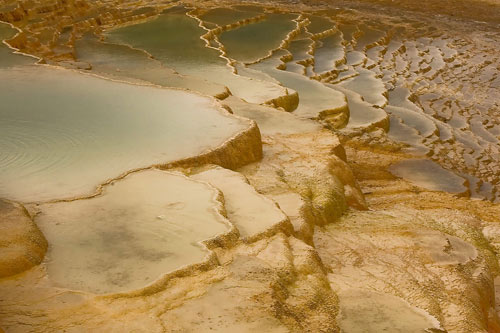mineral spring

Stepped travertine terrace formations at Badab-e Surt, Iran.
When rain falls on the Earth, some of it runs off as streams and rivers; some evaporates back into the air. But some soaks into the ground, through layers of the Earth's crust that are permeable. Lower down, there may be an impermeable layer – that is, one through which the water cannot pass. The water will gather above this layer, and sometimes flows along it, below the ground, until it comes out again at the surface of a hillside, forming a spring which is often a source of pure, drinkable water.
Sometimes, though, as it flows below the ground, the water may pass among rock containing mineral substances that will dissolve in water. Then, when it reaches the surface, it will no longer be pure but will contain some of these minerals in solution.
Often the minerals dissolved are limestone or gypsum – that is, calcium carbonate or sulfate. Then the water is hard; it will not easily form a lather with soap and may have to be softened by various means before it can be used.
If the water contains other dissolved substances it may have valuable properties as a medicine. There are mineral springs of this kind in many places in the world, and, in the past, they were belived to be so effective for treating rheumatism, gout, and various internal disorders that whole towns have been built in those places, so that people can go there for medical treatment.
Some mineral springs contain large quantities of carbon dioxide, which makes them sparking, or effervescent. Other curative springs contain chlorides, carbonates, and sulfates or sodium, calcium, magnesium, and iron, and some sulfides.


